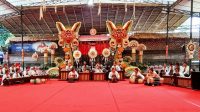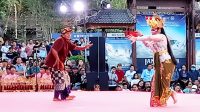ULUN Danu Batur Temple in Kintamani, Bangli, retains a unique and special history of Bali. Why? Within the temple, as a place of prayer for Hindus, there is also a Chinese Shrine as a place of prayer for Chinese descendant citizens. However, the shrine is designed in Balinese architectural style and looks no different from other shrines nearby.
According to historical notes, the Batur Chinese shrine has existed since ancient times as stated in Raja Purana and Batur chronicles. It is stated that the shrine is the place to enthrone Ida Sanghyang Widhi (God) in the form of Ida Ratu Gede Ngurah Subandar. Then, he is believed to be Shiva-Buddha.
In addition, in the Chinese shrine in Bali also resides Goddess Kwan Im, Lord Kwang Ong or the God of Wisdom and the God of the Earth.
At all times, the followers of both faiths pray together and mingle to worship him harmoniously. However, they do it in accordance with their own belief. This indicates the interfaith harmony in Bali at that time.
Hindu pilgrims customarily say prayers first at Ulundanu Batur Kintamani Temple, and then it is resumed to Besakih Temple.
Cultural Acculturation
Both faiths live in close proximity harmoniously. The two cultures resulted in acculturation and this occurred during the reign of Jayapangus as the King of Balingkang in the twelfth century.
The king Jayapangus is told to get married with Chinese girl, Kang Cing Wie. The story of his eternal love is then symbolized with a pair of barong landung in the form of a Balinese man with dark brown skin and big eyes and a woman with olive skin and slanted eyes.
The couple in the figure of barong landung represents a Balinese-Chinese cross-cultural marriage that took place in the twelfth century. Until now, this legend is still well known and much respected by the Balinese people.
In ancient times, it is said that barong landung was often performed to ward off evil influences and bring peace to the people. For example, when an epidemic occurs amidst the community, the barong landung will be performed around the village. All villagers put offerings and after that they get holy water as symbol of God’s blessing to be sprinkled on family members.
Apart from a pair of barong landung, the acculturation of Balinese-Chinese culture also produced several dances that are still inherited today, such as the existence of various kinds of baris or warrior dances showing off troop’s heroism in warfare. They are Baris Presi, Baris Tamiang, Baris Bajra, Baris Dadap, Baris Tumbak and Baris Cina.
In the Bali-China trade contacts at that time, perforated coins were used as a means of transaction. Uniquely, until now the Balinese people still use it but for different purposes, namely as ritual paraphernalia in the ceremony.










